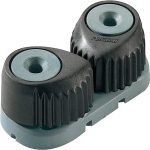Table of Contents
Cleats are essential fixtures on a sailboat used to secure lines (ropes) and control sail trim. They come in various designs and are strategically placed throughout the boat to provide convenient and secure attachment points. Here, I will describe the different types of cleats found on a sailboat in detail:
Sailboat Cleat Types
Horn Cleat
The horn cleat is the most common and recognizable type of cleat. It features one or more protruding horns or arms that provide multiple options for securing lines. The line is wrapped around the horns in a figure-eight pattern to create a secure hold. Horn cleats come in different sizes and are used for various applications throughout the boat, including halyards, sheets, and control lines.
Recommended Horn Cleats:


Schaefer Mid-Rail Chock and Cleat Mounts on 1-1/4 x 3/16-Inch T-Track fits Up to 5/8-Inch/16mm Line
Cam Cleat
Cam cleats are designed with a spring-loaded cam mechanism that clamps down on the line when it is under tension. The cam grips the line securely and holds it in place until released. Cam cleats are popular for applications where quick and easy adjustment is required, such as controlling jib or spinnaker sheets. They are commonly found on sailboats with high-performance or racing-oriented setups.
Recommended Cam Cleats:
Jam Cleat
Jam cleats, also known as jamming cleats or rope clutches, are designed to hold a line firmly under load. They feature a set of ridges or teeth that grip the line when it is tensioned. Jam cleats provide a secure hold and are often used for halyards, control lines, and other high-load applications. To release the line, it needs to be pulled at a specific angle to disengage the teeth.
Recommended Jam Cleats:


Clam Cleat
Clam cleats consist of two interlocking jaws that close around the line. As the line is pulled, the jaws grip it tightly, creating a secure hold. Clam cleats are often used for smaller lines, such as control lines on dinghies or small sailboats. They provide quick and easy adjustment and are commonly found on boats where weight and simplicity are crucial.
Recommended Clam Cleats:
V Cleat
V cleats, as the name suggests, have a V-shaped groove that runs along the top surface of the cleat. The line is inserted into the groove, and the V-shaped design holds it securely in place. V cleats are primarily used for smaller-diameter lines or control lines. They are commonly found on dinghies and small sailboats where space and weight are at a premium.
Recommended V Cleats:
Jammer
Jammers are similar to jam cleats but offer a more sophisticated and mechanical gripping mechanism. They consist of one or more jaws that grip the line under tension using a cam or lever system. Jammers provide a strong and secure hold and are commonly used for halyards, control lines, and sheets on larger sailboats or racing-oriented setups.
Recommended Jammers:
Rope Clutch
Rope clutches are heavy-duty cleats often used on larger sailboats. They consist of multiple jaws or disks that can be engaged or disengaged to secure or release a line. Rope clutches are designed to handle high loads and are commonly used for controlling halyards, sheets, and other lines that require precise adjustment and secure holding power.
Recommended Rope Clutches:
Deck Cleat
Deck cleats, also known as mooring cleats, are larger cleats that are permanently mounted to the deck or cockpit of a sailboat. They provide a secure attachment point for dock lines, fenders, and other lines used for docking or securing the boat. Deck cleats are usually made of durable materials such as stainless steel or aluminum and are designed to handle significant loads.
Recommended Deck Cleats:
Fairlead Cleat
Fairlead cleats combine the functionality of a cleat with that of a fairlead, which helps guide lines to the appropriate cleating position. They feature an integrated fairlead or a combination of a fairlead and a cleat. Fairlead cleats are commonly used for jib or genoa sheet control lines, where it is important to guide the line for optimal sail trim and secure it quickly.
Recommended Fairlead Cleats:
Jamming Block with Cleat
This type of cleat is a combination of a jammer or a cam cleat with a pulley or block. It allows the line to be redirected and creates a mechanical advantage when trimming sails. Jamming blocks with cleats are commonly used for applications that require increased purchase or control, such as mainsheet systems or complex control line setups.
Recommended Jamming Block Cleats:
It’s important to note that the specific cleat types and their placement on a sailboat can vary depending on the boat’s design, rigging setup, and intended use. Sailboat owners and manufacturers may also develop unique variations or combinations of cleats to suit their specific needs. Proper installation, sizing, and maintenance of cleats are essential for safe and efficient sail handling.






























